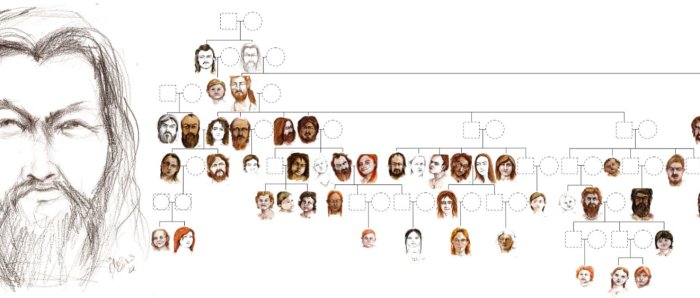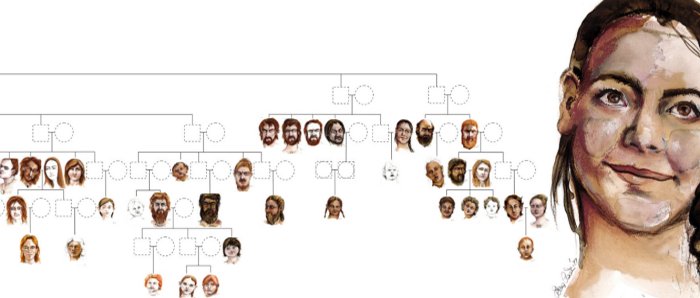Conny Waters – AncientPages.com – The Neolithic lifestyle, based on farming instead of hunting and gathering, emerged in the Near East around 12,000 years ago and contributed profoundly to the modern way of life. The ability to produce and store extra food led Neolithic people to develop new social customs built on wealth, and therefore form social hierarchies.

The “founding father” of the cemetery died elsewhere but was reburied at Gurgy. He must have been of great significance to the close kin group who used the cemetery. Credit: Drawing by Elena Plain; reproduced with the permission of the University of Bordeaux / PACEA
After an early phase of diffusion and having reached regions in western Europe, settled societies became more complex, which is sometimes reflected in the funerary world as well. The Paris Basin region in northern modern-day France is known for its monumental funerary sites, understood as being built for the society’s “elite.” In this context, the site of Gurgy “Les Noisats,” one of the biggest Neolithic funerary sites without monument in the region, begs the question who these people buried with different practices were.
Using new methods for obtaining and analyzing ancient DNA data, and by sampling nearly every individual from the flat cemetery, researchers from the PACEA laboratory in Bordeaux, France, and from the Max Planck Insтιтute for Evolutionary Anthropology in Leipzig, Germany, reveal two mᴀssive family trees which open a window into the lives of the people of this prehistoric community. The work is published in the journal Nature.
Mᴀssive family trees
In their study, the scientists analyzed genome-wide ancient DNA data from 94 individuals buried at Gurgy, combined with strontium isotope ratio values, mitochondrial DNA (maternal lineages) and Y-chromosome (paternal lineages) data, age-at-death, and genetic Sєx. Two family trees could be reconstructed, the first connecting 64 individuals over seven generations is the largest pedigree reconstructed from ancient DNA to date, while the second connects twelve individuals over five generations.
“Since the beginning of the excavation, we found evidence of a complete control of the funerary space and only very few overlapping burials, which felt like the site was managed by a group of closely related individuals, or at least by people who knew who was buried where,” says Stéphane Rottier from the University of Bordeaux, the archaeo-anthropologist who excavated the site between 2004 and 2007. Indeed, a positive correlation between spatial and genetic distances showed that the deceased were likely to be buried close to a relative.
Insights into the social structure of Gurgy
Exploring the pedigrees revealed a strong patrilineal pattern, where each generation is almost exclusively linked to the previous generation through the biological father, which connects the entire group of Gurgy through the paternal line.
At the same time, combined evidence from mitochondrial lineages and strontium stable isotope revealing a non-local origin of most women suggested the practice of patrilocality, meaning that the sons stayed where they were born, and had children with females from outside of Gurgy. Settling in with the male partner’s home community is known as virilocality.
By contrast, most of the lineage adult daughters are missing, in line with female exogamy, potentially indicating a reciprocal exchange system.
Interestingly, these “new incoming” female individuals were only very distantly related to each other, meaning that they must have come from a network of nearby communities, instead of just one nearby group. This lends support to the existence of a relatively wide and potentially fluid exchange network comprising many (including smaller) groups.

Reconstructed family tree of the largest genetically related group in Gurgy: The painted portraits are an artistic interpretation of the individuals based on physical traits estimated from DNA (where available). The dotted squares (genetically male) and circles (genetically female) represent individuals who were not found at the site or did not provide sufficient DNA for analysis. Credit: Drawing by Elena Plain; reproduced with the permission of the University of Bordeaux / PACEA
Looking at the family trees, Maïté Rivollat, first author of the study, says, “We observe a large number of full siblings who have reached reproductive age. Combined with the expected equal number of females and significant number of deceased infants, this indicates large family sizes, a high fertility rate and generally stable conditions of health and nutrition, which is quite striking for such ancient times.”
Another notably unique feature at Gurgy is a lack of half-siblings, suggesting neither polygamous nor serial monogamous reproductive partnerships (or the exclusion of offspring from these unions from the main cemetery), when compared to the, so far, only other example of union practices from Neolithic megaliths.
A founding ancestor
In the frame of this patrilocal system, one male individual from which everyone in the largest family tree was descended could be identified as the “founding father” of the cemetery. His burial is unique at the site, as his skeletal remains were buried as a secondary deposit inside the grave pit of a woman, for whom, unfortunately, no genomic data could be obtained. Therefore, his bones must have been brought from wherever he had originally died to be reburied at Gurgy.
“He must have represented a person of great significance for the founders of the Gurgy site to be brought there after a primary burial somewhere else,” explains Marie-France Deguilloux from the University of Bordeaux, co-senior author of the study.
Although the main pedigree spans seven generations, the demographic profile suggests that a large family group spanning several generations arrived at the site. With almost no subadults buried at the site during the first few generations, and by contrast no adult burials in the last generations, only a short use of the site is expected. The group must have left a previous site, leaving behind any previously deceased children but still brought the lineage father.
Only a few generations later the same happened: the adult of the last generations left Gurgy for another place, leaving behind their own children. Hence, Gurgy was probably only used for three to four generations, or approximately one century.
These largest pedigrees reconstructed to date from ancient human DNA data, combined with multiple lines of evidence, represent an unprecedented step forward in our understanding of the social organization of past societies.
“Only with the major advances in our field in very recent years and the full integration of context data it was possible to carry out such an extraordinary study. It is a dream come true for every anthropologist and archaeologist and opens up a new avenue for the study of the ancient human past,” concludes Wolfgang Haak of the Max Planck Insтιтute for Evolutionary Anthropology, senior author of the study.
Paper
Written by Conny Waters – AncientPages.com Staff Writer





